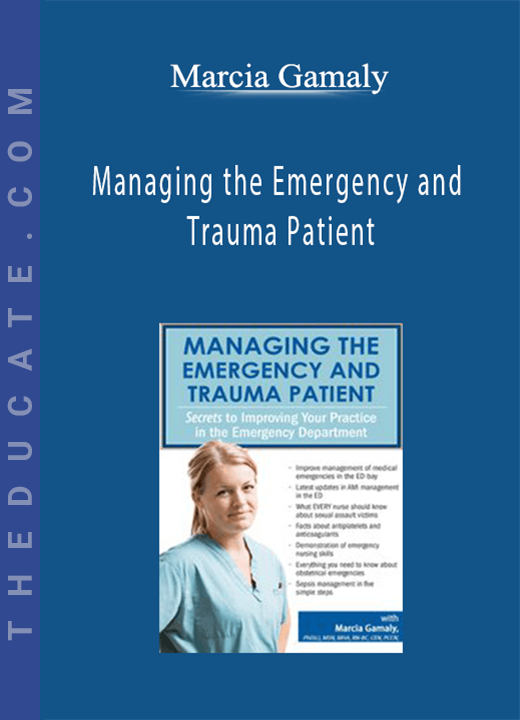Description
Managing the Emergency and Trauma Patient: Secrets to Improving Your Practice in the Emergency Department – Marcia Gamaly
- Improve management of medical emergencies in the ED bay
- Latest updates in AMI management in the ED
- What EVERY nurse should know about sexual assault victims
- Facts about antiplatelets and anticoagulants
- Demonstration of emergency nursing skills
- Everything you need to know about obstetrical emergencies
- Sepsis management in five simple steps
You can achieve these professional goals…
- You are ten hours into your 12-hour shift. You have had challenging cases all day, and get a report that you will be receiving a Level 1 trauma patient in 6 minutes. Imagine approaching this patient with improved confidence in your ability to accurately assess the patient, anticipate their care needs, and manage complications when they arise.
- Don’t fear calls from risk management or the patient safety officer! Develop confidence in the care you provide and document on each and every patient.
- Improve patient outcomes and your ability to provide care by learning essential skills EVERY emergency nurse needs to know!
- Immediately apply content learned using real-life critical thinking scenarios that are easily remembered!
- Compare and contrast spinal cord syndromes.
- Plan care for the patient experiencing chest pain.
- Distinguish differences between life-threatening maxillofacial and neck traumas.
- Recommend management strategies for the patient presenting with acute stroke symptoms.
- Determine the hemorrhagic risk of patients receiving anticoagulants.
- Evaluate the effectiveness of interventions to treat acute and chronic pain.
- Formulate appropriate nursing care for the transgender victim of sexual assault.
- Choose appropriate patient-specific interventions for the bariatric patient.
Trends in Emergency and Trauma Nursing
- Current trends
- Core measures
- Hospital scorecards
Head and Neck Trauma
- Neurological trauma
- ESSENTIAL SKILL:
- ED management of the stroke patient
- Maxillofacial and neck trauma
- HANDS-ON SKILL VIDEO:
- Proper application and management of cervical collar
- ESSENTIAL SKILL:
- NIHSS scoring
Thoracic/Abdominal/Genitourinary Trauma
- Thoracic trauma
- ESSENTIAL SKILL:
- Assessment of the patient with a chest tube
- Abdominal trauma
- HANDS-ON SKILL VIDEO:
- Intra-abdominal pressure assessment and management
- Genitourinary trauma
- HANDS-ON SKILL VIDEO:
- Chest tube insertion and chest tube management
- HANDS-ON SKILL VIDEO:
- Chest auto-transfusion
- ESSENTIAL SKILL:
- Pelvic fractures
Extremity Trauma
- Musculoskeletal trauma
- HANDS-ON SKILL VIDEO:
- Hare traction
- HANDS-ON SKILL VIDEO:
- Conversion of Hare traction to Bucks traction
- ESSENTIAL SKILL:
- Hemorrhage management
Special Considerations
- Psychosocial issues
- Obstetrical emergencies
- The bariatric patient
- Pediatric emergencies
- Shock
- HANDS-ON SKILL VIDEO:
- Defibrillation, cardioversion and pacing
- HANDS-ON SKILL VIDEO:
- Rapid infuser
- HANDS-ON SKILL VIDEO:
- Essential dysrhythmia recognition & treatment
Trends in Care
- Chest pain
- Antiplatelets versus anticoagulants
- Pre-hospital care
- Sexual assault
- Sexual assault of the transgender patient
- Forensic issues
- Ultrasound guided peripheral IV placement
- Pressure injuries
- Insulin pumps
Skills Demonstration
Salepage: http://href.li/?https://catalog.pesi.com/item/27057/







6 reviews for Managing the Emergency and Trauma Patient: Secrets to Improving Your Practice in the Emergency Department – Marcia Gamaly
There are no reviews yet.